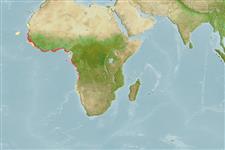Elasmobranchii (sharks and rays) >
Carcharhiniformes (Ground sharks) >
Leptochariidae (Barbeled houndsharks)
Etymology: Leptocharias: Etymology not explained, perhaps leptos (Gr.), slender; [Car]charias, i.e., a slender shark “very nearly related to Carcharias” (See ETYFish); smithii: In honor of Andrew Smith (1797-1872), Scottish military physician, explorer, ethnologist and zoologist, who collected many South African sharks and coined many of the shark names later used by Müller and Henle (See ETYFish).
Eponymy: Dr Sir Andrew Smith (1797–1872) was a Scotsman who joined the Army Medical Service (1819) after graduating from Edinburgh University. [...] (Ref. 128868), visit book page.
More on authors: Müller & Henle.
Environment: milieu / climate zone / depth range / distribution range
Ecology
Marine; brackish; demersal; depth range 10 - 75 m (Ref. 244), usually 10 - 60 m (Ref. 5377). Tropical; 20°C - 27°C; 22°N - 23°S, 26°W - 17°E
Eastern Atlantic: Mauritania to Namibia (Ref. 127434).
Size / Weight / Age
Maturity: Lm ? range ? - ? cm
Max length : 77.0 cm TL male/unsexed; (Ref. 244); 82.0 cm TL (female); common length : 55.0 cm TL male/unsexed; (Ref. 26999)
Similar to species of Mustelus but nostrils with anterior flaps formed into distinct barbels (Ref. 5485).
Found on the continental shelf, especially abundant off river mouths on muddy bottoms. Salinity: 35-36 ppt. Oxygen: 3-4 ppm. Feeds on small bottom and littoral organisms like crustaceans, bony fishes, octopi and sponges. Viviparous (Ref. 50449), with 7 young in a litter (Ref. 244). Dental sexual dimorphism is manifested by males having greatly enlarged anterior teeth. Utilized fresh, smoked or dried salted for human consumption, skin for leather.
Life cycle and mating behavior
Maturity | Reproduction | Spawning | Eggs | Fecundity | Larvae
Viviparous, placental (Ref. 50449), with 7 young in a litter (Ref. 244). Distinct pairing with embrace (Ref. 205).
Compagno, L.J.V., 1984. FAO Species Catalogue. Vol. 4. Sharks of the world. An annotated and illustrated catalogue of shark species known to date. Part 2 - Carcharhiniformes. FAO Fish. Synop. 125(4/2):251-655. Rome: FAO. (Ref. 244)
IUCN Red List Status (Ref. 130435: Version 2024-1)
Threat to humans
Harmless
Human uses
Fisheries: minor commercial
Tools
Special reports
Download XML
Internet sources
Estimates based on models
Preferred temperature (Ref.
123201): 19.2 - 28, mean 26 °C (based on 116 cells).
Phylogenetic diversity index (Ref.
82804): PD
50 = 1.5000 [Uniqueness, from 0.5 = low to 2.0 = high].
Bayesian length-weight: a=0.00389 (0.00180 - 0.00842), b=3.12 (2.94 - 3.30), in cm total length, based on all LWR estimates for this body shape (Ref.
93245).
Trophic level (Ref.
69278): 3.8 ±0.49 se; based on food items.
Resilience (Ref.
120179): Very Low, minimum population doubling time more than 14 years (Fec=7).
Fishing Vulnerability (Ref.
59153): Moderate to high vulnerability (53 of 100).
